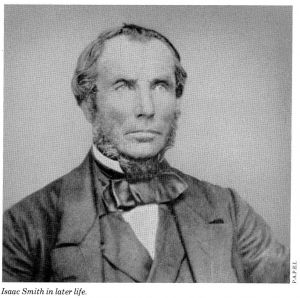When William George Wright married Sarah Dennis on 28 December 1848, there were two witnesses to the marriage listed on the marriage record: Isaac Smith, Jr. and James Douglas.

As I have written before (and here and here), William Wright was a carpenter or builder in Charlottetown, and there are several historic houses that can be tied directly to him. Proving that the house builder and the ancestor are the same person isn’t at a 100% “fact” yet, but using some cluster research on one of the names of the marriage witnesses moves it that much closer.
 Isaac Smith, Jr. was born in Charlottetown in 1822 to Isaac Smith and Jane Smith. Isaac, the senior, was one of the most prominent builders, contractors and architects for the capitol region of PEI:
Isaac Smith, Jr. was born in Charlottetown in 1822 to Isaac Smith and Jane Smith. Isaac, the senior, was one of the most prominent builders, contractors and architects for the capitol region of PEI:
Wherever the future Fathers of Confederation looked in the Charlottetown of 1864, they would have been confronted with the work of builder/architect Isaac Smith. They conferred in a legislative building designed by Isaac Smith. On the same square, coming and going from the sessions which conceived the Dominion of Canada, they could observe an Episcopal church designed and built by Isaac Smith, and a round market house constructed by him. They were feted in a Lieutenant Governor’s residence designed and built by Isaac Smith. The very ship carrying the Canadian delegates had been guided into Charlottetown harbour by a lighthouse designed by—Isaac Smith. (Source)
It would only be appropriate to think that Isaac the son would follow in his father’s footsteps, and the fact that William Wright was is the same business also lends itself to the same conclusion that the witness to my ancestor’s wedding was in fact the son of the famous Isaac Smith. Taking it another step, the same magazine article the above quotation was taken from notes that Isaac Smith worked on several of his projects with one Nathan Wright. Finally, both William Wright and Isaac Smith were lay pastors in the Methodist Church. Could this Nathan Wright be my ancestor William’s father? Did the business (and religious and potentially personal) relationship between Isaac and Nathan directly resulted in the friendship of William and Isaac, Jr.? I, for one, would have to answer yes to both questions.
And now that I am thinking about it, how would have my ancestor Stephen H. Lewis–a much accomplished homebuilder in Somerville, Massachusetts, after emigrating from Nova Scotia–have met William’s daughter Laura when he was born and schooled in Five Islands, N.S.? Well, look at this line from his biography:
Mr. Lewis was employed for two years by an uncle at Prince Edward Island
Eureka!
Though proving Nathan and William to be father and son is still on the docket, there is little doubt in my mind that the Wrights who built many of the great structures of 19th century Charlottetown with the more accomplished Smiths are in fact relatives, if not my direct ancestors.
 WHY IS THIS PLACE IMPORTANT?
WHY IS THIS PLACE IMPORTANT?